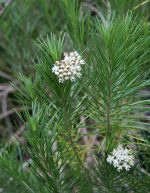 Also called pine-needle milkweed, this evergreen herbaceous perennial or subshrub is a member of the dogbane family, Apocynaceae, that also includes periwinkle. It is native to Arizona, New Mexico, and the southern most part of California where it grows on dry rocky slopes, ridges, mesas, in canyons, and oak pine juniper woodland. Plants grow up to 5′ tall, but usually 2-3′ tall, and have milky sap and branched reddish stems that become woody from the bottom up with age. The narrow green leaves are sessile, dense, alternately or spirally arranged, and resemble pine needles, hence the common names pine-leaf/needle milkweed. From February to December subterminal and lateral .75-1.5″ wide umbels of 10 or more small white flowers appear. Each flower has reflexed petals surrounding pink or purplish tipped rounded hoods with horns attached at the center. The fruit is a tear-shaped follicle containing many plumed seeds. Plants are very heat and drought tolerant and are hosts for monarch butterflies. A good choice for a butterfly or xeric garden. The genus name, Asclepias, honors the Greek God of healing Asklepios. The specific epithet, linaria, may be from the Greek word linon meaning flax and refers to the resemblance of the linear leaves to those of flax.
Also called pine-needle milkweed, this evergreen herbaceous perennial or subshrub is a member of the dogbane family, Apocynaceae, that also includes periwinkle. It is native to Arizona, New Mexico, and the southern most part of California where it grows on dry rocky slopes, ridges, mesas, in canyons, and oak pine juniper woodland. Plants grow up to 5′ tall, but usually 2-3′ tall, and have milky sap and branched reddish stems that become woody from the bottom up with age. The narrow green leaves are sessile, dense, alternately or spirally arranged, and resemble pine needles, hence the common names pine-leaf/needle milkweed. From February to December subterminal and lateral .75-1.5″ wide umbels of 10 or more small white flowers appear. Each flower has reflexed petals surrounding pink or purplish tipped rounded hoods with horns attached at the center. The fruit is a tear-shaped follicle containing many plumed seeds. Plants are very heat and drought tolerant and are hosts for monarch butterflies. A good choice for a butterfly or xeric garden. The genus name, Asclepias, honors the Greek God of healing Asklepios. The specific epithet, linaria, may be from the Greek word linon meaning flax and refers to the resemblance of the linear leaves to those of flax.
Type: Evergreen herbaceous perennial or subshrub
Bloom: Umbels of small white flowers from February to December
Size: 2-5′ h 2-3′ W
Light: Full sun
Soil: Average, dry, well-drained
Hardiness: Zones 9-11
Care: Low maintenance
Pests and Diseases: None of significance
Propagation: Seed
Companion Plants: Autumn sage, penstemon, artemesia
Photo Credit: Wikipedia